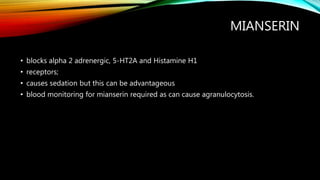The document discusses various aspects of mental depression and its classifications, prevalence, causes, symptoms, and treatment methods, including psychotherapy, drug therapy, and alternative treatments. It highlights the significance of neurotransmitters in the development of depression and the historical evolution of antidepressant treatments, emphasizing their efficacy and associated risks. The document also addresses the limitations of antidepressants and outlines the safety concerns regarding their use, particularly in specific populations like pregnant women.

















































![OTC ANTIDEPRESSANTS
• Hypericum perforatum [St. John's Wort (SJW)]
• Tryptophan – precursor in serotonin biosynthesis
• 5-Hydroxytryptophan (5-HTP) – precursor in serotonin biosynthesis
• Ademetionine [S-Adenosyl-L-methionine (SAMe)] – cofactor in monoamine
neurotransmitter biosynthesis
• Rubidium chloride [RbCl] (Rubinorm) – unknown/unclear mechanism of action](https://image.slidesharecdn.com/depressionantidepressants-191011103149/85/Depression-Anti-depressants-50-320.jpg)































































































